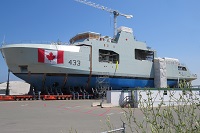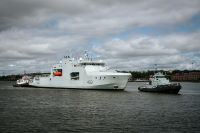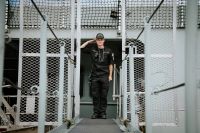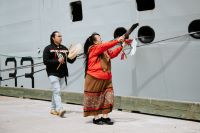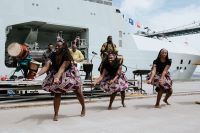|

HMCS
WILLIAM HALL 433
Harry
DeWolf Class Arctic and Offshore Patrol Vessel
|

|
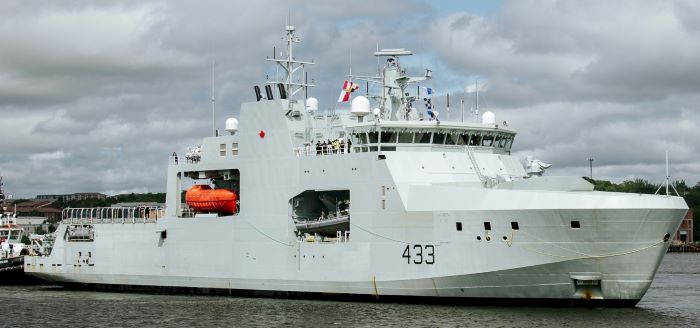
HMCS WILLIAM HALL 433
|
|
Laid Down: 17
Feb 2021
Floated
up: 27 Nov 2022
Delivered:
31 Aug 2023
|
Commissioned: 16
May 2024, Halifax, NS
Paid off: |
On
27 Nov 2022, the future HMCS WILLIAM HALL was floated up in Bedford Basin,
Halifax, NS.
On
28 Apr 2023 the official Naming Ceremony of the future HMCS WILLIAM HALL,
the fourth Arctic and Offshore Patrol Ship (AOPS) being built at the Halifax
Shipyard for the Royal Canadian Navy (RCN), took place.
The
ship was officially named in a ceremony with the Ships Sponsor, Chief
Superintendent Craig Gibson (Ret’d) of the Royal Canadian Mounted Police,
who was the first Black person to be promoted to the rank of Chief
Superintendent as the Commanding Officer for “L” Division, Prince Edward
Island. Gibson is also the first male to ever be appointed Sponsor for an
HMC Ship. Gibson was raised in Gibson Woods, a small Black community where
descendants of William Hall settled as Black Loyalists.
The
son of former American slaves, William Hall was the first Black person, the
first Nova Scotian and one of the first Canadians to receive the British
Empire’s highest award for bravery, the Victoria Cross, for his bravery
during the Seige of Lucknow during the Indian Rebellion of 1857.
“Conditions
were harrowing,” said the Honourable Anita Anand, Minister of National
Defence, at the ceremony. “Somehow managing to evade the barrage of enemy
fire as their friends and shipmates fell all around them, in the end—of
His Majesty’s Ship Shannon crew—only Hall and another officer were left
standing.”
On
31 Aug 2023, WILLIAM HALL was accepted by the RCN from the builder, 2 months
ahead of schedule. She was Commissioned 16 May 2024 at Halifax, NS..
On
03 Jun 2024, HMCS WILLIAM HALL arrived in La Havre, France becoming the
first AOPV to complete a transatlantic voyage. The WILLIAM HALL will
take part in Operation Distinction commemorating the 80th anniversary of
D-Day.
Photos
and Documents
Ship's Company Photos
|
WILLIAM
NELSON EDWARD HALL, V.C.
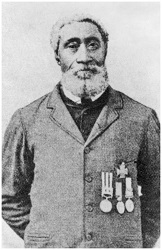 William
Hall's Royal Navy career coincided with a period of rapid and often violent
expansion of British imperial power worldwide: in eastern Asia, on the Indian
subcontinent, and elsewhere. While Hall had no role in shaping imperial policy,
the actions of which he was a part were instrumental in extending and
consolidating colonial rule over large parts of the non-British world. These
actions should be understood in the context of the broader processes of
imperialism and resistance of which they are a part. The conflict in which Hall
was decorated is today understood as the Indian Rebellion of 1857, a sustained
campaign of resistance to the British East India Company's abusive
governance. William
Hall's Royal Navy career coincided with a period of rapid and often violent
expansion of British imperial power worldwide: in eastern Asia, on the Indian
subcontinent, and elsewhere. While Hall had no role in shaping imperial policy,
the actions of which he was a part were instrumental in extending and
consolidating colonial rule over large parts of the non-British world. These
actions should be understood in the context of the broader processes of
imperialism and resistance of which they are a part. The conflict in which Hall
was decorated is today understood as the Indian Rebellion of 1857, a sustained
campaign of resistance to the British East India Company's abusive
governance.
William
Hall was the first Black person, the first Nova Scotian and one of the first
Canadians to receive the British Empire’s highest award for bravery, the
Victoria Cross.The son of former American slaves, Hall was born in 1827 at
Horton, Nova Scotia, where he also attended school. He grew up during the age of
wooden ships, when many boys dreamed of travelling the world in sailing vessels.
As a young man, Hall worked in shipyards at Hantsport for several years,
building wooden ships for the merchant marine. He then joined the crew of a
trading vessel and, before he was eighteen, had visited most of the world’s
important ports.
Perhaps
a search for adventure caused young William Hall to leave a career in the
American merchant navy and enlist in the Royal Navy in Liverpool, England, in
1852. His first service, as Able Seaman with HMS Rodney, included two years in
the Crimean War. Hall was a member of the naval brigade that landed from the
fleet to assist ground forces manning heavy gun batteries, and he received
British and Turkish medals for his work during this campaign.
After
the Crimean War, Hall was assigned to the receiving ship HMS Victory at
Portsmouth, England. He then joined the crew of HMS Shannon as Captain of the
Foretop. It was his service with Shannon that led to the Victoria Cross.
Shannon,
under Captain William Peel, was escorting troops to China, in readiness for
expected conflict there, when mutiny broke out among the sepoys in India. Lord
Elgin, former Governor General of Upper Canada and then Envoy Extrodinary to
China, was asked to send troops to India. The rebel sepoy army had taken Delhi
and Cawnpore, and a small British garrison at Lucknow was under siege. Elgin
diverted troops to Calcutta and, as the situation in India worsened, Admiral
Seymour also dispatched Shannon, Pearl and Sanspareil from Hong Kong to
Calcutta. Captain Peel, several officers, and about 400 seamen and marines
including William Hall, travelled by barge and on foot from Calcutta to Cawnpore,
dragging eight-inch guns and twenty-four-pound howitzers.
Progress
was slow with fighting all along the way. At Cawnpore the Shannon crew joined
another relief force under Sir Colin Campbell (later to become
Lieutenant-Governor of Nova Scotia) and began the historic march to Lucknow.
The
key to Lucknow was the Shah Najaf mosque, a walled structure itself enclosed by
yet another wall. The outer wall was breached by the 93rd Highlanders at
mid-day, and the Shannon brigade dragged its guns to within 400 yards (366 m) of
the inner wall. William Hall volunteered to replace a missing man in the crew of
a twentyfour- pounder. The walls were thick, and by late afternoon the 30,000
sepoy defenders had inflicted heavy casualties from their protected positions.
The bombardment guns from Shannon were dragged still closer to the walls and a
bayonet attack was ordered, but to little effect. Captain Peel ordered two guns
to within 20 yards (18 m) of the wall. The enemy concentrated its fire on these
gun crews until one was totally annihilated. Of the Shannon crew, only Hall and
one officer, Lieutenant Thomas Young, were left standing.
Young
was badly injured, but he and Hall continued working the gun, firing, reloading,
and firing again until they finally triggered the charge that opened the walls.
“I remember,” Hall is quoted as saying, “that after each round we ran our
gun forward, until at last my gun’s crew were actually in danger of being hurt
by splinters of brick and stone torn by the round shot from the walls we were
bombarding.”
Captain
Peel recommended William Hall and Thomas Young for the Victoria Cross, in
recognition of their “gallant conduct at a twenty-four-pounder gun... at
Lucknow on the 16th November 1857”.
Hall
received his Victoria Cross aboard HMS Donegal in Queenstown Harbour, Ireland,
on October 28, 1859. His naval career continued aboard many ships, among them
Bellerophon, Hero, Impregnable, Petrel and Royal Adelaide, until he retired in
1876 as Quartermaster.
Hall
moved back to Nova Scotia to live with his sisters, Rachel Robinson and Mary
Hall, on a farm in Avonport overlooking the Minas Basin. A modest man, he lived
and farmed without recognition until 1901, when HRH the Duke of Cornwall and
York (later King George V) visited Nova Scotia. A parade of British veterans was
held, and Hall wore his Victoria Cross and three other service medals. The Duke
inquired about the medals and drew attention to Hall’s service.
Three
years later, William Hall died at home, of paralysis, and was buried without
military honours in an unmarked grave. In 1937, a local campaign was launched to
have Hall’s valour recognized by the Canadian Legion, but it was eight more
years before his body was reburied in the grounds of the Hantsport Baptist
Church. The monument erected there bears an enlarged replica of the Victoria
Cross and a plaque that describes Hall’s courage and devotion to duty.
Subsequently,
a branch of the Canadian Legion in Halifax was renamed in his honour. A
gymnasium in Cornwallis, the DaCosta-Hall Educational Program for Black students
in Montreal, and the annual gun run of the International Tattoo in Halifax also
perpetuate his name.
In
1967, William Hall’s medals were returned to Canada from England to be shown
at Expo ‘67 in Montreal. As property of the Province of Nova Scotia, they were
later transferred to the Nova Scotia Museum.
Source:
Maritime Museum of the Atlantic
|

The badge of
HMCS WILLIAM HALL
Photos and Documents
(BG01-BG03)
The
future HMCS WILLIAM HALL at the Irving Shipyards, Halifax, with her center and stern mega blocks positioned for
joining together - 10 Jun 2022. The forward mega block
is under construction.
(BG04)
The
future HMCS WILLIAM HALL at the Irving Shipyards, Halifax, with her forward
block positioned for
joining - 06 Aug 2022 Courtesy
of Barry Gerrard
|

WH01
|

WH02
|
(WH01)
The
future HMCS WILLIAM HALL in Bedford Basin shortly before being floated-up
- 28 Nov 2022 // DND/RCN
photo (WH02)
The
future HMCS WILLIAM HALL under tow after being floated-up in
Bedford Basin, Halifax, NS on 28 Nov 2022 // DND/RCN photo
(WH03 -
WH05) The
future HMCS WILLIAM HALL was delivered to and accept by the RCN on 30 Aug
2023 Source:
RCN's Facebook page
(WH06-WH09)
The Commissioning of HMCS WILLIAM HALL
Source: RCN's
Facebook page
HOME PAGE SHIP INDEX
CONTACT
|








